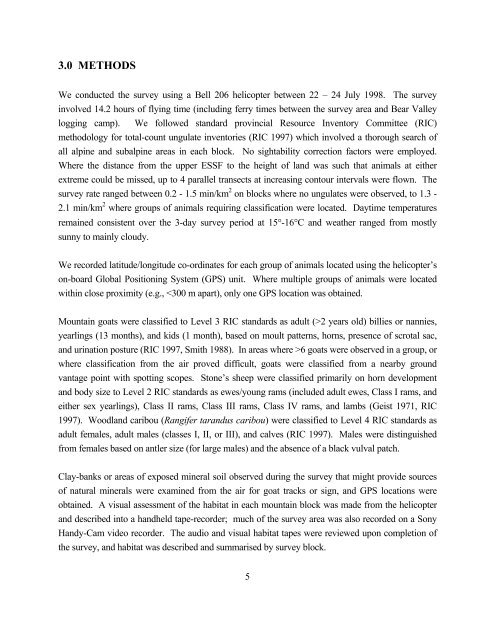Summer inventory of mountain goats and Stone's sheep ... - BC Hydro
Summer inventory of mountain goats and Stone's sheep ... - BC Hydro
Summer inventory of mountain goats and Stone's sheep ... - BC Hydro
Create successful ePaper yourself
Turn your PDF publications into a flip-book with our unique Google optimized e-Paper software.
3.0 METHODS<br />
We conducted the survey using a Bell 206 helicopter between 22 – 24 July 1998. The survey<br />
involved 14.2 hours <strong>of</strong> flying time (including ferry times between the survey area <strong>and</strong> Bear Valley<br />
logging camp). We followed st<strong>and</strong>ard provincial Resource Inventory Committee (RIC)<br />
methodology for total-count ungulate inventories (RIC 1997) which involved a thorough search <strong>of</strong><br />
all alpine <strong>and</strong> subalpine areas in each block. No sightability correction factors were employed.<br />
Where the distance from the upper ESSF to the height <strong>of</strong> l<strong>and</strong> was such that animals at either<br />
extreme could be missed, up to 4 parallel transects at increasing contour intervals were flown. The<br />
survey rate ranged between 0.2 - 1.5 min/km 2 on blocks where no ungulates were observed, to 1.3 -<br />
2.1 min/km 2 where groups <strong>of</strong> animals requiring classification were located. Daytime temperatures<br />
remained consistent over the 3-day survey period at 15°-16°C <strong>and</strong> weather ranged from mostly<br />
sunny to mainly cloudy.<br />
We recorded latitude/longitude co-ordinates for each group <strong>of</strong> animals located using the helicopter’s<br />
on-board Global Positioning System (GPS) unit. Where multiple groups <strong>of</strong> animals were located<br />
within close proximity (e.g., 2 years old) billies or nannies,<br />
yearlings (13 months), <strong>and</strong> kids (1 month), based on moult patterns, horns, presence <strong>of</strong> scrotal sac,<br />
<strong>and</strong> urination posture (RIC 1997, Smith 1988). In areas where >6 <strong>goats</strong> were observed in a group, or<br />
where classification from the air proved difficult, <strong>goats</strong> were classified from a nearby ground<br />
vantage point with spotting scopes. Stone’s <strong>sheep</strong> were classified primarily on horn development<br />
<strong>and</strong> body size to Level 2 RIC st<strong>and</strong>ards as ewes/young rams (included adult ewes, Class I rams, <strong>and</strong><br />
either sex yearlings), Class II rams, Class III rams, Class IV rams, <strong>and</strong> lambs (Geist 1971, RIC<br />
1997). Woodl<strong>and</strong> caribou (Rangifer tar<strong>and</strong>us caribou) were classified to Level 4 RIC st<strong>and</strong>ards as<br />
adult females, adult males (classes I, II, or III), <strong>and</strong> calves (RIC 1997). Males were distinguished<br />
from females based on antler size (for large males) <strong>and</strong> the absence <strong>of</strong> a black vulval patch.<br />
Clay-banks or areas <strong>of</strong> exposed mineral soil observed during the survey that might provide sources<br />
<strong>of</strong> natural minerals were examined from the air for goat tracks or sign, <strong>and</strong> GPS locations were<br />
obtained. A visual assessment <strong>of</strong> the habitat in each <strong>mountain</strong> block was made from the helicopter<br />
<strong>and</strong> described into a h<strong>and</strong>held tape-recorder; much <strong>of</strong> the survey area was also recorded on a Sony<br />
H<strong>and</strong>y-Cam video recorder. The audio <strong>and</strong> visual habitat tapes were reviewed upon completion <strong>of</strong><br />
the survey, <strong>and</strong> habitat was described <strong>and</strong> summarised by survey block.<br />
5
















